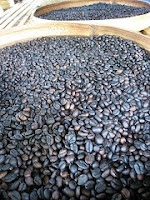Executive Summary about Roast Coffee by Kenneth Elliott
 Roast Coffee. Roasting coffee is a skillful art that starts with a carefully selected coffee bean that either goes through a washing system to separate beans or dry system.
Roast Coffee. Roasting coffee is a skillful art that starts with a carefully selected coffee bean that either goes through a washing system to separate beans or dry system.
The process of washing a bean is used to remove the fleshy fruit from the bean. This process is used to differentiate and separate different kinds of beans. The density differences in the beans will cause some to float higher, this makes it easy to separate and sort the many kinds of beans.
Dry-processed beans produce a more subtle acid profile. In contrast the acidity of wet-processed beans produce a more striking acidic flavor. Acidity in coffee is good thing. The alternative is a flat, lifeless cup of coffee.
What happens to beans as they heat up during roasting?
In the first stage the beans absorb the heat and the raw bean (known as green beans - un-roasted or raw) are slowly dried to a yellowish tinge. If the beans are properly done, the beans will have an odor reminiscent of toast or popcorn.
When the temperature of the beans reach 170°C-200°C (338°F-392°F) the sugars in the beans will begin to caramelize. This process is aided by the increase in temperature of the moisture enclosed by the skin. In this stage it is important that the beans have the correct moister content. Without the correct moister content the beans will not be able to caramelize the sugars correct.
Temperature reaches around 230°C (446°F) and the beans become medium-dark brown and take on an oily sheen.
Now, the roaster has to be very careful as to not burn the beans. During this stage the beans can be striped of their desirable flavors leading to a burnt taste. Too light a roast will leave too high a concentration of bitter compounds in the final product. Too dark will produce an excessively chocolaty, burnt taste.

No comments:
Post a Comment